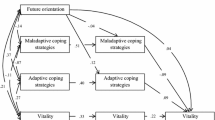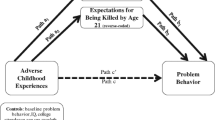This study examined the ability of future certainty—an individual's perception of future stability, operationalized as the likelihood of certain life outcomes–to explain variance in delinquency and school adjustment, while controlling for economic, neighborhood, and family factors, among a cross-sectional sample of 1422 male and 1562 female African American adolescents drawn from the National Longitudinal Study of Adolescent Health (Add Health). Three kinds of future certainty were examined: future life certainty (e.g., life expectancy), marriage certainty, and college certainty. In hierarchical multiple regression analyses, future certainty and family functioning were stronger predictors than economic and neighborhood variables: neighborhood disorganization and family socioeconomic status. Future life certainty and expectations of attending college were stronger predictors of delinquency among males than females. Marriage certainty was the weakest predictor of the three certainty variables.
Similar content being viewed by others
REFERENCES
Aneshensel, C. S., and Sucoff, C. A. (1996). The neighborhood context of adolescent mental health. J. Health Soc. Behav. 37: 293–310.
Barber, C. N., Ball, J., and Armistead, L. (2003). Parent–adolescent relationship and adolescent psychological functioning among African-American female adolescents: Self-esteem as a mediator. J. Child Fam. Stud. 12(3): 361–374.
Bearman, P. S., Jones, J., and Udry, J. R. (1998). The National Longitudinal Study of Adolescent Health: Research Design. Retrieved January 15, 1999 from http://www.cpc.unc.edu/projects/addhealth/design.html.
Belsky, J., Steinberg, L., and Draper, P. (1991). Childhood experience, interpersonal development, and reproductive strategy: An evolutionary theory of socialization. Child Dev. 62: 647–670.
Bronfenbrenner, U. (1979). The Ecology of Human Development: Experiments by Nature and Design. Harvard University Press, Cambridge, MA.
Brook, J. S., Adams, R. E., Balka, E. B., Whiteman, M., Zhang, C., and Sugerman, R. (2004). Illicit drug use and risky sexual behavior among African American and Puerto Rican urban adolescents: The longitudinal links. J. Genet. Psychol. 165: 203–220.
Bureau of Justice Statistics (2003). Victim Characteristics, Summary Findings. Retrieved November 15, 2004, from http://www.ojp.usdoj.gov/bjs/cvict_v.htm.
Bynum, E. G., and Weiner, R. I. (2002). Self-concept and violent delinquency in urban African-American adolescent males. Psychol. Rep. 90: 477–486.
Caldwell, C. H., Kohn-Wood, L. P., Schmeelk-Cone, K. H., Chavous, T. M., and Zimmerman, M. A. (2004). Racial discrimination and racial identity as risk or protective factors for violent behaviors in African American young adults. Am. J. Community Psychol. 33(1/2): 91–105.
Chisholm, J. S. (1993). Death, hope, and sex: Life-history theory and the development of reproductive strategies. Curr. Anthropol. 34: 1–24.
Chung, H., and Elias, M. (1996). Patterns of adolescent involvement in problem behaviors: Relationship to self-efficacy, social competence, and life events. Am. J. Community Psychol. 24: 771–784.
Cleveland, H. H. (2003). Disadvantaged neighborhoods and adolescent aggression: Behavioral genetic evidence of contextual effects. J. Res. Adolesc. 13: 211–238.
Cloward, R., and Ohlin, L. (1960). Delinquency and Opportunity. Free Press, New York.
Cohen, J., and Cohen, P. (1983). Applied Multiple Regression: Correlation Analysis for the Behavioral Sciences (2nd edn). Erlbaum, New York.
Cross, W. E. (2003). Tracing the historical origins of youth delinquency & violence: Myths & realities about Black culture. J. Soc. Issues 59(1): 67–82.
Dornbusch, S. M., Erickson, K. G., Larid, J., and Wong, C. A. (2001). The relation of family and school attachment to adolescent deviance in diverse groups and communities. J. Adolesc. Res. 16: 396–422.
Farrington, D. P., and West, D. J. (1995). Effects of marriage, separation, and children on offending by adult males. In Hagen, J. (ed.). Current Perspectives on Aging and the Life Cycle: Delinquency and Disrepute in the Life Course. CT: JAI Press, Greenwich, pp. 249–281.
Fiegelman, S., Howard, D. E., Li, X., and Cross, S. I. (2000). Psychosocial and environmental correlates of violence perpetration among African American youth. J. Adolesc. Health 27: 202–209.
Flannery, D. J., Williams, L. L., and Vazsonyi, A. T. (1999). Who are they with and what are they doing? Delinquent behavior, substance use, and early adolescents’ after-school time. Am. J. Orthopsychiatry 69: 247–253.
Florsheim, P., Tolan, P., and Gorman-Smith, G. (1996). Family processes and risk for externalizing behavior problems among African American and Hispanic boys. J. Consult. Clin. Psychol. 64, 1222–1230.
Friedman, A. S., and Glassman, K. (2000). Family risk factors versus peer risk factors for drug abuse: A longitudinal study of an African American urban community sample. J. Substance Abuse Treatment 18: 267–275.
Furstenberg, F. F. (1993). How families manage risk and opportunity in dangerous neighborhoods. In Wilson, W. J. (ed.), Sociology and the Public Agenda. Sage, Newbury Park, CA pp. 231–258.
Goldenberg, J. L., Pyszsczynski, T., McCoy, S. K., Greenberg, J., and Solomon, S. (1999). Death, sex, love, and neuroticism: Why is sex such a problem? J. Pers. Soc. Psychol. 77: 1173–1187.
Gonzales, N. A., Cauce, A. M., Friedman, R. J., and Mason, C. A. (1996). Family, peer, and neighborhood influences on academic achievement among African-American adolescents: One-year prospective effects. Am. J. Comm. Psychol. 24: 365–386.
Gottfredson, M. R., and Hirschi, T. (1990). A General Theory of Crime. Stanford University Press, CA.
Harper, G. W., and Robinson, W. L. (1999). Pathways to risk among inner-city African American female adolescents: The influence of gang membership. Am. J. Comm. Psychol. 27(1): 383–404.
Hill, E. M., Ross, L. T., and Low, B. S. (1997). The role of future unpredictability in human risk-taking. Hum. Nat. 8: 287-325.
Hindelang, M. J., Hirschi, T., and Weis, J. (1981). Measuring Delinquency. Sage, Beverly Hills.
Hirschi, T., and Gottfredson, M. R. (1995). Control theory and the life-course perspective. Stud. Crime Crime Prev. 4: 131–142.
Hoge, R. D., Andrews, D. A., and Leschied, A. W. (1996). An investigation of risk and protective factors in a sample of youthful offenders. J. Child Psychol. Psychiatry Allied Discip. 37: 419–424.
Joseph, J. (1996). School factors and delinquency: A study of African American Youths. J. Black Stud. 26(3): 340–355.
Keough, K. A., Zimbardo, P. G., and Boyd, J. N. (1999). Who's smoking, drinking, and using drugs? Time perspective as a predictor of substance abuse. Basic Appl. Soc. Psychol. 21: 149–164.
McLoyd, V. C. (1990). The impact of economic hardship on black families and children: Psychological distress, parenting, and socioemotional development. Child Dev. 61, 311–346.
Moffitt, T. E. (1993). Adolescent-limited and life-course-persistent antisocial behavior: A developmental taxonomy. Psychol. Rev. 100: 674–701.
Office of Juvenile Justice and Delinquency Prevention (2003). Population statistics. Retrieved November 15, 2004, from http://ojjdp.ncjrs.org/ojstatbb/population/index.html.
Ogbu, J. U. (1988). Cultural diversity and human development. New Dir. Child Dev. 42: 11–28.
Ogbu, J. U. (1994). Racial stratification and education in the United States: Why inequality persists. Teach. Coll. Rec. 96: 264–298.
Ogbu, J. U., and Stern, P. (2001). Caste status and intellectual development.). In Sternberg, R., and Grigorenko, E. (eds.), Environmental Effects on Cognitive Abilities. Lawrence Erlbaum, Mahwah, NJ, pp. 3–37.
Parham, T. A., White, J. L., and Ajamu, A. (2000). The Psychology of Blacks (3rd edn). Prentice Hall, New Jersey, pp. 24–38.
Peeples, F., and Loeber, R. (1994). Do individual factors and neighborhood context explain ethnic differences in juvenile delinquency? J. Quant. Criminol. 10: 141–157.
Rutter, M., Giller, H., and Hagell, A. (1998). Antisocial Behavior by Young People. Cambridge University Press, New York.
Sampson, R. J. (1997). Collective regulation of adolescent misbehavior: Validation results from eighty Chicago neighborhoods [Special Issue]. J. Adolesc. Res. 12: 227–244.
Sampson, R. J., and Laub, J. H. (1993). Crime in the Making: Pathways and Turning Points Through Life. Harvard University Press, Cambridge, MA.
Sampson, R. J., Morenoff, J., and Earls, F. (1999). Beyond social capital: Spatial dynamics of collective efficacy for children. Am. Sociol. Rev. 74: 633–660.
Shaw, C. R., and McKay, H. D. (1969). Juvenile Delinquency and Urban Areas. University of Chicago Press, Chicago.
Sheidow, A. J., Gorman-Smith, D., Tolan, P. H., and Henry, D. B. (2001). Family and community characteristics: Risk factors for violence exposure in inner-city youth. J. Comm. Psychol. 29: 345–360.
Solomon, S., Greenberg, J., and Pyszsczynski, T. (1999). A terror management theory of social behavior: The psychological functions of self-esteem and cultural worldviews. In Zanna, M. P. (ed.), Advances in Experimental Social Psychology. Academic Press, San Diego, CA, pp. 91–159.
Tatum, B. L. (1996). An analysis of factors contributing to the delinquency of Black youth. J. Black Stud. 26(3): 356–368.
Taylor, R. D., and Roberts, D. (1995). Kinship support and maternal and adolescent well-being in economically disadvantaged African-American families. Child Dev. 66: 1585–1597.
Unger, D. G., and Wandersman, A. (1985). The importance of neighbors: The social, cognitive, and affective components of neighboring. Am. J. Comm. Psychol. 13: 1985.
United States Census Bureau (2003). Poverty-Current Population Survey. Retrieved November 15, 2004, from http://www.census.gov/hhes/www/poverty.html.
Vazsonyi, A. T., and Flannery, D. J. (1997). Early adolescent delinquent behaviors: Associations with family and school domains. J. Early Adolesc. 17: 271–293.
Walsh, A. (1997). Methodological individualism and vertical integration in the social sciences. Behav. Philos. 25: 121–136.
Wiebe, R. P. (2004). Expanding the model of human nature underlying the General Theory of Crime: Implications for the constructs of self-control and opportunity. Aust. N Z J. Criminol. 37: 65–84.
Wilson, M., and Daly, M. (1997). Life expectancy, economic inequality, homicide, and reproductive timing in Chicago neighborhoods. Br. Med. J. 314: 4.
Wilson, G., and Dunham, R. (2001). Race, class, and attitudes toward crime control: The views of the African American middle class. Crim. Justice Behav. 28: 259–278.
Zimbardo, P. G., and Boyd, J. N. (1999). Putting time in perspective: A valid, reliable, individual-differences metric. J. Pers. Soc. Psychol. 77: 1271–1288.
Zimmerman, M. A., and Maton, K. I. (1992). Life-style and substance use among male African-American urban adolescents: A cluster analytic approach. Am. J. Comm. Psychol. 20: 121–138.
Author information
Authors and Affiliations
Corresponding author
Rights and permissions
About this article
Cite this article
Caldwell, R.M., Wiebe, R.P. & Cleveland, H.H. The Influence of Future Certainty and Contextual Factors on Delinquent Behavior and School Adjustment Among African American Adolescents. J Youth Adolescence 35, 587–598 (2006). https://doi.org/10.1007/s10964-006-9031-z
Published:
Issue Date:
DOI: https://doi.org/10.1007/s10964-006-9031-z




